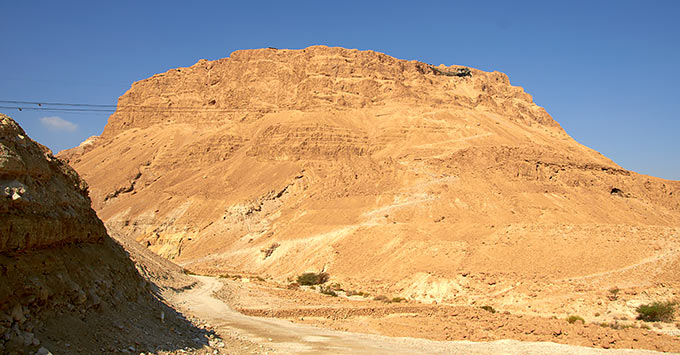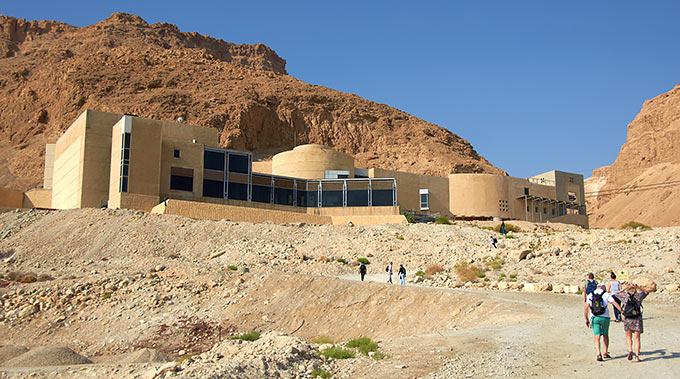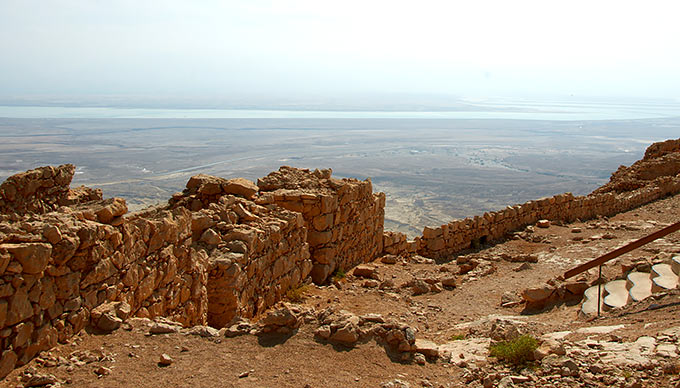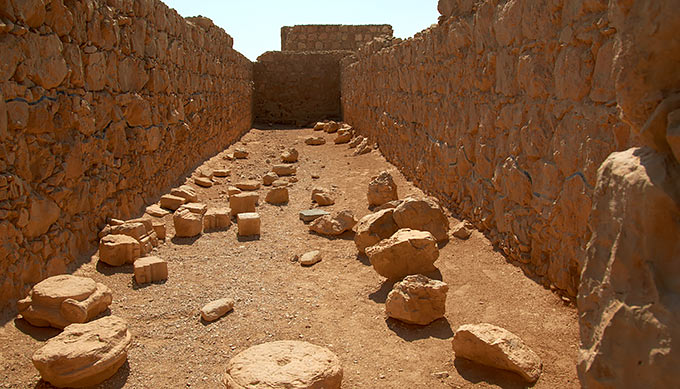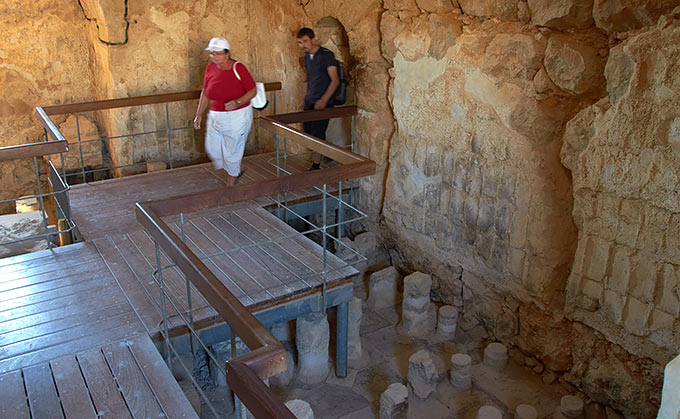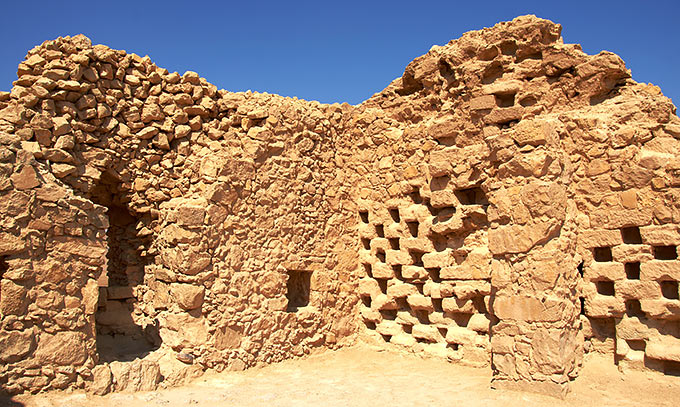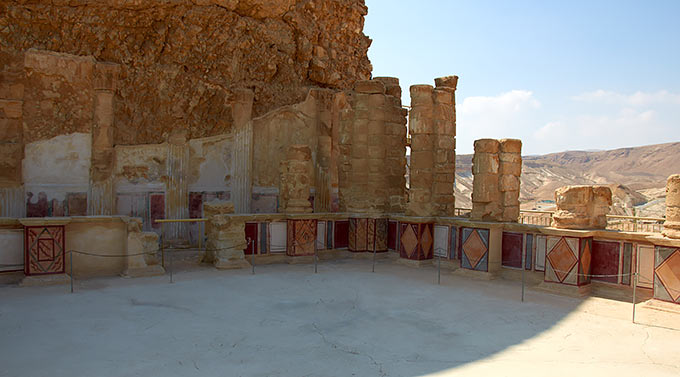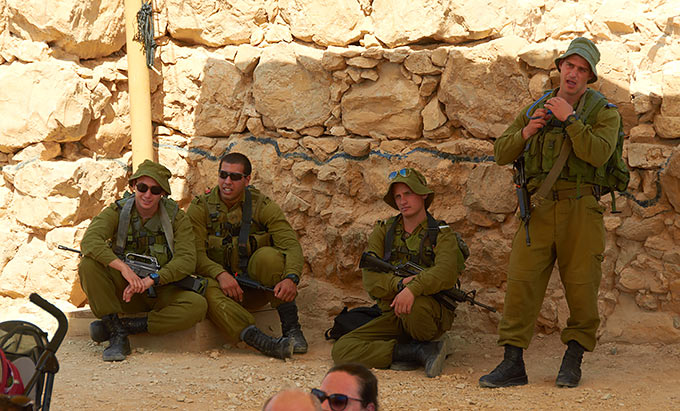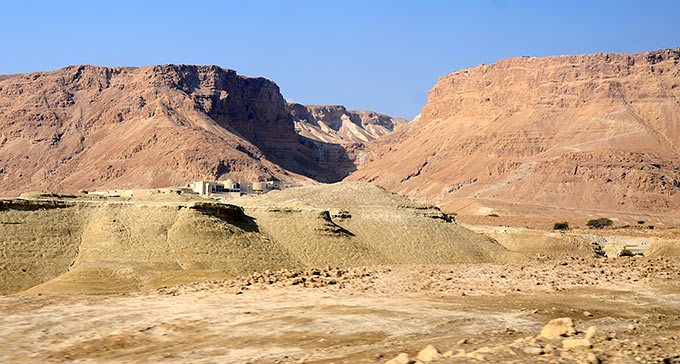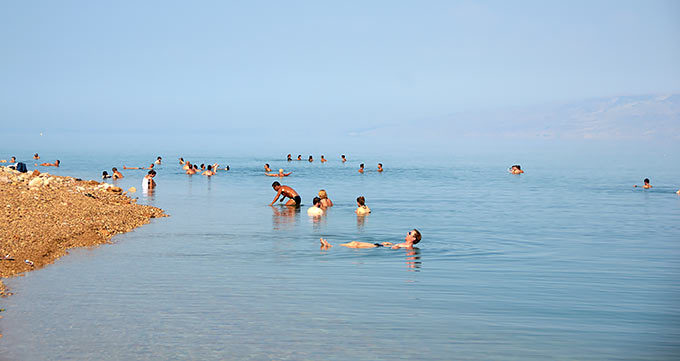Fortress Masada*
Rocky cliff of great height is surrounded on all it sides by steep precipices impenetrable depths and inaccessible for either humans or animals; there are only in two places, and only with difficulty, you can get in: one of these roads lies to the east of Asphalt Lake (Dead Sea), and another, more passable, - to the west of the cliff... High priest Jonathan first built a fortress and called it Masada. Later, Herod spent a lot of work to bring it to the kind of luxury - wrote Joseph (Ben Mattitihu) Josephus in 'The Jewish War'.
This author is essentially the only documentary source for this object. Pliny in his 'Naturalis Historia' (77 AD) mentioned some fortress on the banks of Asphalt Lake (Dead Sea). No one knew until 1838 where is located, while American archaeologists Eli Smith and Edward Robinson, who investigated the western shore of the Dead Sea, do not specify the exact location of the famous fortress. In 1842, missioner Samuel Walcott and painter William Tipping were first Europeans climbed the top of Masada from the east.
In 1851 de Salsa made a plan of the fortress, and in 1875 K. Conder took precise map of the area. In 1909, A. Domashevsky examined the remains of Roman fortifications around Masada and made their precise plan. Since the beginning of the 1920s these places begun to visit Jews, for which Masada since that time has become a symbol of national resistance and heroism (especially after the publication in 1927 of the epic poem 'Masada' by I.Lamdan. A quote from his poem 'Masada will never fall again' was the slogan the Zionist movement of the 1930s).
In 1942 the British command in Cairo, had a plan to fortified these places and stop Rommel, if he conquered Egypt and move on. Palmach fighters** had to be in the garrison of this stronghold.
In 1953, 1955-56 and 1959. Shmarja Gutman held the first excavations of Roman camps and discovered the North palace in the fortress. Finally, in 1963-65 by Hebrew University were initiated large-scale excavations of Masada. Director and organizer of the expedition was Yigael Yadin - professor and former Chief of Staff of the Israeli Defense Forces. The work involved hundreds of volunteers from around the world. All built-up part of the fortress has been cleared and partially restored. Processing of the results of this expedition is still ongoing. During the excavations remains of 28 people were found in 1969 they were buried with military honors.
In 2001, Masada was included in to UNESCO World Heritage Fund. In 2007 a new building of the museum was to the cable car to Masada mount became to operate.
Ancient history of Masada is closely tied to modern politics, as the fortress now serves as a national symbol of resistance of Jewish people in a hostile Arab environment. Passions are boiled and in the heat of a scientific argument is easy to get in חוטם (snout - Hebrew.) or خطم (snout - the Arabs.) depending on your position in scientific debate.
So, what do we know for sure?
Josephus wrote about the 'high priest Jonathan' who built the fortress. This was a name of the Jewish Hasmonean King Alexander Jannaeus. Coins of that times were found at Masada. So it can be assumed that the fortress was founded in 103-76 BC.
In 40 BC. Herod the Great (that time he was just Herod and pretender to Judea throne) hid his family at Masada, when he went to Rome for the label to reign in Judea. The fortress withstood the siege of the last Hasmonean king Antigonus II due to large stocks of food and water. The 37 BC Herod returned with a Roman army, deposed Antigonus was crucified, and Herod became the ruler of the Judea as part of the Roman Empire.
That Herod was not popular among the Judea people, to say the least of it, but was loved by official Rome (nickname 'The Great' was given to him by the Romans). He felt himself in the 'promised land' very uncomfortable and because of it had built everywhere fortresses and reconstructed and fortified Masada in 37-31 BC.
First all the plateau was surrounded by a 5.5 m high white stone casemated wall end the wall had 5 dozen interior rooms to accommodate the garrison. 38 towers of 20-meter height towered above the wall. In the western part of the fortress was erected a vast palace with all the amenities, as well as with thick walls and watchtowers at the corners, and in the north part of plateau another luxurious Palace-Villa, extensive administrative and warehouse complex, baths with hot sauna and a huge swimming pool. The central part of the plateau was taken by gardens.
What about the water supply? 8 huge cisterns with a capacity of 40000 cubic meters were cut down at north-west side of the Masada mountain. During a short winter rains system of dams and aqueducts directed water from rivers to these cisterns and then water in jugs on donkeys was delivered to the top of Masada Mount store in the fortress. It was enough for the garrison and also referred for the bath with sauna, swimming pool, fountains, gardens and everything else.
After Herod's death in 4 BC Rome embedded on the territory of Judea it's direct rule and permanent Roman garrison of several dozen people was installed in the fortress.
Roman rule was not gentle at all, procurators were despots, local government riddled with corruption, and all Judaea, naturally was flourished with ideas of separatism. And in 66 AD, 'someone named Manaim, son of Judas, surnamed the Galilean' at the head of the local rebel army of Sicaries *** took Masada by surprise, slain the Roman garrison and arming its allies with weapons from rich arsenals of the fortress, proclaimed himself king of Judah, and came to Jerusalem . Thus the 1st Jewish War began.
After Manaim killing in the internecine war in Jerusalem, his nephew Elazar ben Yair fled to Masada and headed local Jewish Zealots. In the 70 AD the troops of the Roman general Titus Flavius took Jerusalem, and burnt the Second Temple. In the hands of the rebels were only three small fortresses, including Masada.
Fall of 73 AD Lucius Flavius Silva with an X Legion (Legio X Fretensis) all about 10-15 thousand, Including support troops, blocked Masada fortress and began to build a siege ramp by forces of captured Jews rebels from Jerusalem. By May 74 AD the ramp was ready and Romans dragged the siege tower on the top of it and begun battering to destroy the wall of the fortress.
Besieged rebels realized that further resistance was futile, however, preferred death to humiliation and slavery. They chose among themselves 10 people who killed all others, and then another one, who killed these ten, and then committed suicide himself. And all of them were, according to Josephus, were 967 people, half of whom were women and children. That's the story.
After the defeat of the Jewish uprising there was a Roman garrison in the fortress for about 60 years, after that the Romans abandoned the fortress, probably demolished its fortifications, so nobody could use them.
In the 5-7 centuries Byzantine monks inhabited the fortress, because all the area belonged to the Basileus of Constantinople. Monks not only prayed, but spied on as far as possible, that was common for this kind of outposts. In the 7th century monastery even received the status of lavra, but with the advent of the Arabs in these places the monks had to clear the area. Since then, nobody disturbed these sad ruins, except for rare incursions of Bedouins who sought monastic treasures in the remains of the old church.
*Masada - metzadá, מצדה - fortress, stronghold.
**Palmach- פַּלְמַ"ח,
acronym פְּלוּגּוֹת-מַחַץ,
- plugot mahats - assault companies, military units of Hagana (Jewish underground organization in Palestine in 1920-1948).
***Sukkar - a radical wing of the Zealots (zealous), the name comes from the latin word Sika(knife, dagger). They like to use these knifes to cut down theirs political opponents and Roman collaborators.
Impressions
Impressions are wonderful! First of all I never seen such an ancient fortress. Roman siege 2-thousand-year-old fortifications looks like fortification of the Crimean War or the First World War here in Russia. Antiquity are everywhere in Israel - in stone, sand, and dust, creaking on the teeth... Judean Desert! All these biblical scenery! It is the sun (in the afternoon of October +40°C) !. These canyons, cliffs, plateaus, dry river bed where .
Modern civilization is present and sometime it is quite a lot, but, all done very dosed and does not obstruct any of antiquity. These landscapes are imprinted in the memory with theirs colors, dust and the scorching sun for a long long time, if not forever ...
I almost forgot, there is a the Dead Sea and and I've made attempt to swim there! You can only swim on your back in that water, while half you stick out from the water level and you feel like a fool...
Land forts and fortress:
Bip Castle Gatchina Ivangorod Izborsk Kexholm Kirillov Monastery Koporye Novgorod Pechorskiy Monastery Peter&Paul Fortress Porkhov Pskov Schlisselburg Staraya Ladoga Tikhvin Vyborg Hameenlinna Hamina Kastelholm Kymenlinna Lappaenranta Raseborg Castle Savonlinna Tavetti Turku Visby Fredrikstadt Fredriksten Hegra Fort Hoytorp Fort Arensburg Narva Tallinn Antipatris Caesarea Jerusalem Latrun Fort Masada
Sea forts and fortresses:
Alexander Fort Ino Fort Krasnaya Gorka Fort Kronstadt: Kotlin isl. Kronstadt: North Forts Kronstadt: South Forts Trongsund Hanko Svartholm Sveaborg Marstrand Siaro Fort Vaxholm Oscarsborg
Artillery batteries and individual guns:
Coastal Artillery Hemso Fort
Fortified areas and defensive lines:
Karelian Fortified Area (KaUR) KrUR Leningrad Mannerheim Line Nevsky Bridgehead VT Line Harparskog Line Salpa Line Gothland
Russian
S e a r c h All news

